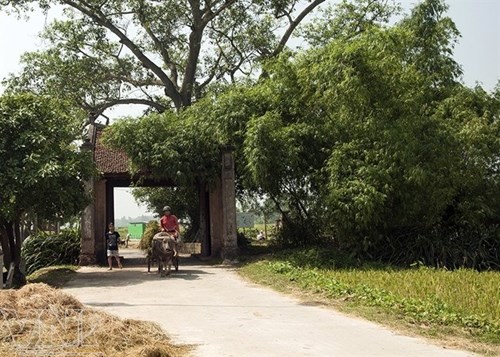The conference was recently held at the Hanoi Museum with the participation of many cultural managers and researchers. They delivered an overall view on the current situation of cultural and historical vestiges in Hanoi, pointed out shortcomings in the management of relics in the city and discussed solutions to preserve and promote heritage sites in the city effectively.
    |
 |
|
The gate of Duong Lam Village |
Hanoi is praised as a city of rich cultural heritage. Indeed, as a 1,000-year-old city, Hanoi is the cradle of nearly 6,000 cultural and historical relics, counting to 2016. Over 2,000 relics have been recognized as national heritage and provincial heritage treasures, according to Ngo Van Quy, Vice Chairman of the municipal People’s Committee.
The heritage items and sites are diverse, including pre-historic military architecture (An Duong Vuong, built before 208BC); key areas from the resistance wars against the French and Americans; imperial architecture and artifacts from the Ly Dynasty (the 10th century) to the Nguyen Dynasty (1802-1945) and religious spaces, as Hanoi is a center of different religions including Buddhism, Mother Goddess worship and Catholicism.
There is huge potential to develop tourism and cultural research in Hanoi. The heritage of the capital also provides inspiration for research and creativity.
"We acknowledge that cultural heritage is a foundation to develop socio-economy of the city," said Quy.
Le Thi Minh Ly, from the Vietnam Cultural Heritage Association, emphasized the importance of sustainable development, especially in the field of cultural heritage. She said that heritage preservation requires comprehensive social and economic development, protecting the environment, peace and security.
“According to UNESCO conventions, we need to focus on preserving and developing at the same time. That means that besides respecting and protecting cultural heritage, we are also concerned about the material and spiritual life of the people who live on the heritage sites, so we need to get the locals involved in all steps of projects to preserve and develop the sites and consult experts during the process,” she said.
That the capital city boasts a huge number of heritage sites is both a point of pride and a challenge at the same time, according to expert Nguyen The Hung from the Cultural Heritage Department of the Ministry of Culture, Sports and Tourism.
“We face many difficulties to strike a balance and harmony between protecting heritage and developing the society,” he said.
“There is a conflict between protecting the archaeological sites and maintaining the rights of people living on the sites.”
He mentioned Duong Lam Old Village in Hanoi’s Son Tay town as a prime example. The local people demanded the right to build new houses or repair their traditional houses because they can’t live in downgraded architectures that are hundreds of years old.
He offered some solutions, such as consulting domestic and foreign experts, raising people’s awareness of the value of heritage sites, developing more tourism products to bring profits to the local people, getting young people involved in protecting and developing the heritage sites, and improving the professionalism of people who work in managing and operating the heritage zones.
Source: VNA